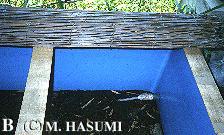

 |
 |
(B) The lower photograph indicates the interior terrarium, the bottom of which is covered with moist soil, sphagnum, decaying wood and leaves, and so forth.
Adult salamanders of Hynobius nigrescens are provided with terrestrial isopods (mainly Porcellio scaber) and earthworms (Pheretima hilgendorfi) as food from mid-April (just after emergence from a breeding pond) until mid-November (just before hibernation).
It had long been believed that in hynobiid salamanders, raising terrestrial adults after emergence from the water throughout the year and thus leading them to breeding were very difficult until 1985 when I performed these events successfully.